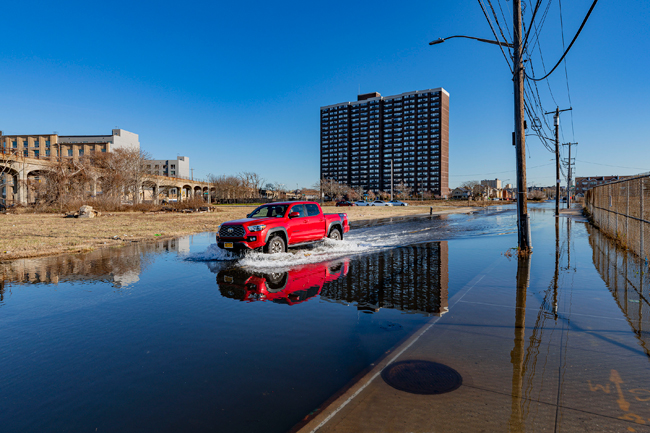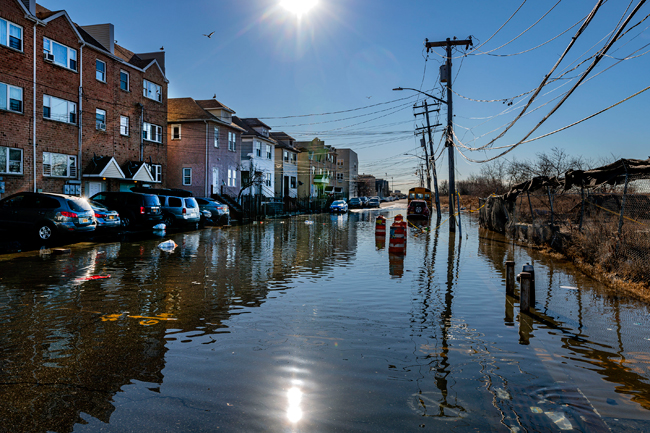
A truck plows down a flooded city street near the shore in Far Rockaway, Queens. This photo was taken on January 4, 2022 during a “sunny day” high tide flood event. Credit: Giles Ashford, NYC Community Flood Watch Project.
— By Chris Gonzales, Freelance Science Writer, New York Sea Grant
Contacts:
Kathy Bunting-Howarth, NYSG's Associate Director, E: keb264@cornell.edu, P: 607-255-2832
Katie Graziano, NYSG Coastal Resilience Extension Specialist, E: kag247@cornell.edu, P: 718-951-5415
New York, NY, April 20, 2022 - It’s been happening with increasing frequency: residents in low-lying waterfront neighborhoods are seeing flooding even on sunny days, when unusually large tides bring high water.
So-called “sunny day” floods, also called “nuisance” or “tidal flooding,” bring a range of impacts to these coastal areas.
Now, a team of researchers has published a paper about the social and emotional impacts of sunny day flooding.1 Their goal is to better engage local knowledge into adaptation planning.
The researchers found that participants in the study—residents in these coastal areas—are knowledgeable about, and engaged with, the “processes, rhythms, and impacts” of tidal flooding. This means they are already adapting to these changes, as we’ll explain below.
This work springs from the efforts of New York City Community Flood Watch civic scientists, and was supported by the Science and Resilience Institute at Jamaica Bay, New York Sea Grant (NYSG), the NYC Mayor’s Office of Resiliency, and the USDA Forest Service Northern Research Station.

An inundated street lies between a city block and the shore in Far Rockaway, Queens. This photo was also taken on January 4, 2022 during a “sunny day” high tide flood event. Credit: Giles Ashford, NYC Community Flood Watch Project.
Significant hazard
The risk of flooding is particularly worrisome in New York City, with its 520 miles of coastline and 400,000 residents living either along the coast or in a FEMA-designated “1% chance” or 100-year floodplain.2 Yet the research team found that there is little qualitative data on social-emotional impacts of chronic flooding.
In this pilot study, researchers sought to understand these impacts and the adaptation strategies people have adopted in response to tidal flooding in communities in Queens, New York.
In particular, they wanted to answer the following questions: What are the social impacts of living with chronic flooding? How are communities already adapting to the changes brought about by tidal flooding? What adaptation strategies can best limit harm from tidal flooding?
“Frequent ‘sunny-day’ flooding will likely increase over time,” said Kathy Bunting-Howarth, NYSG’s associate director and one of the co-authors of the article. “Learning how people currently adapt to these events can shape future resilience planning.”
Setting out, the team uncovered research indicating that experiencing impacts of climate change and natural disasters are associated with PTSD and other anxiety disorders. The extent and frequency of flood exposure also can exacerbate PTSD. Another term, “solastalgia,” refers to a sense of grief experienced after environmental degradation or natural disasters.3 4
Building a backstory
A growing literature documents the impacts of chronic and nuisance flooding. These can include damages to residential property and disruptions to economic activity.
Since sunny day flooding is periodic, researchers realized they would need to draw on a variety of data sources, including eye-witness accounts, photographs, video analyses, and social media. They found, for example, one researcher, in a separate project, used data sources like these to examine impacts in Annapolis, Maryland, which has been experiencing sea level rise at a rate two to four times greater than the global mean and has been setting records for tidal flooding.
Tidal flooding has ecological and human-health implications. Saltwater intrusion threatens freshwater aquifers for drinking water. It also can lead to coastal forest and wetland loss. It can even cause farmers to lose some of their crops.
Health effects can include mold growth which can trigger allergic rhinitis and asthma. Increases in arboviruses can lead to mosquito strains tolerant of salt water and increases in mosquito-borne diseases.
Story Map: "Flood Remediation in the Outer Boroughs of NYC" is a guide to help community members connect with flood remediation resources.
Resilience and adaptation
What is resilience then, in connection with tidal flooding?
One definition of resilience, in a broader context: the ability of social groups “to cope with external stresses and disturbances as a result of social, political, and environmental change.”5
The presence of pre-existing social support, such as healthy intimate partnerships, leads to greater capacity for resilience after a natural disaster.6
Among the adaptations to chronic flooding, the researchers found coastal residents did things like more frequently check tidal charts, regularly moving cars, leaving early or staying out later to avoid flooded streets, or keeping waterproof boots in their vehicles. At the more extreme end, they might buy a high-clearance vehicle such as an SUV. Or retrofit homes to withstand flooding. Or build makeshift berms.
One resident reported that a friend arrives to his job two hours early—at 5:00 a.m.—to avoid floodwaters, then waits in his car for two hours to go to work at 7:00.
NYC Community Flood Watch participants showed themselves to be knowledgeable about tidal flooding and its impacts, the researchers wrote. The interviews they conducted elicited details about the intensity and consequences of this flooding. Going forward, research-action efforts can build on this knowledge, to develop risk plans and communication strategies. All with the aim to build better resilience in coastal communities.
“It is important that we not only understand the visible, physical aspects of flooding, but how flooding impacts home economics, lifestyles and mental health,” said Bunting-Howarth. “Resilience should consider both physical and social factors.”
References
1 Campbell, Lindsay K.; Cheng, Helen; Svendsen, Erika; Kochnower, Dana; Bunting-Howarth, Katherine; and Wapnitsky, Phoebe (2021) "Living with Water: Documenting Lived Experience and Social-Emotional Impacts of Chronic Flooding for Local Adaptation Planning," Cities and the Environment (CATE): Vol. 14: Iss. 1, Article 4. DOI: 10.15365/cate.2021.140104
2 https://floodmaps.fema.gov
3 Padhy, S.K., S. Sarkar, M. Panigrahi, and S. Paul. 2015. Mental health effects of climate change. Indian Journal of Occupational and Environmental Medicine, 19(1), 3.
4 Hammond, M. J., A.S. Chen, S. Djordjevic, D. Butler, and O. Mark. 2015. Urban flood impact assessment: a state-of-the-art review. Urban Water Journal, 12(1), 14-29.
5 Adger, N. 2000. Social and Ecological Resilience: Are they related? Prog. Hum. Geogr., 24, 347–364.
6 Lowe, S.R., J.E. Rhodes, and M.C. Waters. 2015. Understanding resilience and other trajectories of psychological distress: a mixed-methods study of low-income mothers who survived Hurricane Katrina. Current Psychology, 34(3), 537-550.
More Info: New York Sea Grant
New York Sea Grant (NYSG), a cooperative program of Cornell University and the State University of New York (SUNY), is one of 34 university-based programs under the National Oceanic and Atmospheric Administration’s National Sea Grant College Program.
Since 1971, NYSG has represented a statewide network of integrated research, education and extension services promoting coastal community economic vitality, environmental sustainability and citizen awareness and understanding about the State’s marine and Great Lakes resources.
Through NYSG’s efforts, the combined talents of university scientists and extension specialists help develop and transfer science-based information to many coastal user groups—businesses and industries, federal, state and local government decision-makers and agency managers, educators, the media and the interested public.
The program maintains Great Lakes offices at Cornell University, University at Buffalo, SUNY Oswego and the Wayne County Cooperative Extension office in Newark. In the State's marine waters, NYSG has offices at Stony Brook University and Cornell Cooperative Extension of Nassau County on Long Island; at Brooklyn College, with New York City Department of Environmental Protection in Queens and at Cornell Cooperative Extension in NYC and Elmsford and Kingston in the Hudson Valley.
For updates on Sea Grant activities: www.nyseagrant.org has RSS, Facebook, Twitter, Instagram, and YouTube links. NYSG offers a free e-list sign up via www.nyseagrant.org/nycoastlines for its flagship publication, NY Coastlines/Currents, which is published quarterly.